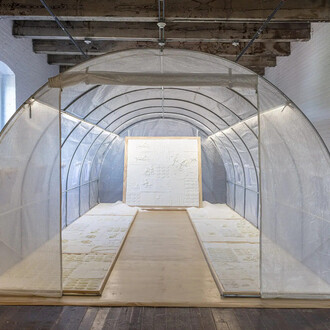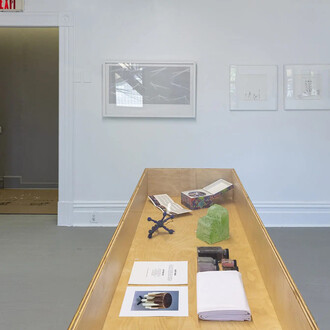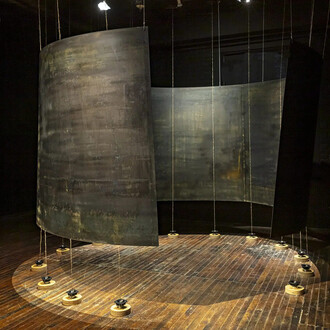Vinyl cutouts on painted wall, jump ropes, framed textile pieces, colored pencil, embroidery and jump ropes on mat board, frames, poly cotton red and white stripe fabric, black cotton fabric, stuffing, wooden roof, plastic picket fence, fabric pieces, found children’s mittens and gloves, Raggedy Ann/Andy doll patterns cover in latex and testosterone gel, wallpaper, vinyl siding, window frames, plexiglass. Greer Lankton’s (red frames) drawings, collages and mixed media pieces from childhood, adolescence and adulthood, Catalina Schliebener Muñoz’s (pink frames) teenage drawings and collage from 1996-1999, archival objects from Greer Lankton Archive, personal ephemera of Catalina Schliebener Muñoz.
The idea for the exhibition Deep, deep woods was born out of the initial encounter with the Greer Lankton Archive during a visit to Mattress Factory in 2022. Queer artist and educator Catalina Schliebener Muñoz (they/them) was struck by some of the uncanny similarities between Lankton’s artistic motifs and their own. Greer Lankton (1958-1996) was a prominent artist during the height of the avant garde art scene in downtown New York in the 1980s and early 90s. As a transgender woman, Lankton centered her work on queerness vis a vis the body by creating portraits across mediums including the handmade dolls that she became known for. Eventually, she received critical acclaim; her work was included in both the Whitney Biennial and the Venice Biennale in 1995. The following year, the Mattress Factory mounted a solo exhibition of Lankton’s work titled It’s all about me, not you. The piece is a monumental, autobiographical installation, comprised of paintings and drawings, iconography, dolls, and ephemera. Framed in a house-like structure, the installation is a reproduction of her home and studio. Lankton died shortly after the opening in late 1996. The museum subsequently acquired Lankton’s archive along with the installation which remains on view.
Though Schliebener Muñoz has worked with similar materials long before they became aware of the Lankton Archives, the connections resonated with them and they conceptualized an exhibition that would stand as a visual dialogue between the two artists. While Lankton’s work focused on corporeality, Schliebener Muñoz interrogates the ways in which educational materials— books, toys, etc.— indoctrinate or teach children how to perceive gender, class, race, and other social constructs. By appropriating familiar characters from children’s books and films and deconstructing them in murals, collages, and other works, the artist creates a dissonance between the objects and the viewer’s relationship to the original stories. Both artists have maximalist approaches, however, in the exhibition, Schliebener Muñoz’s plays with scale in order to amplify iconic imagery from fairy tales that influenced both artists. The artist also chose childhood drawings from their own archive and placed them side-by-side with Lankton’s from a comparable age. These archival works serve to emphasize the art historical kinship between Lankton and Schliebener Muñoz.
(Text by Monique Long)
Muñoz was selected for exhibition by Guest Curator, Monique Long, a New York City-based contemporary art curator and writer through Mattress Factory's annual Regional Open Call. This program is an ongoing effort to amplify the voices and profiles of artists from in and around Pittsburgh by connecting creatives in our community with curators, artists, institutions, and scholars throughout the world.
Artist Statement
I work primarily with collage, drawings, murals, and installations. The subject matter of my work focuses on everyday images and objects related to childhood. Children’s books, pedagogical objects, costumes, and games are frequent sources of material in my work.
Research is a fundamental part of my practice, as is sourcing material on the street, in secondhand stores, and in lost-and-found bins. The starting point for me is always a found object or image that triggers a series of formal and conceptual connections. The time I spend looking for materials slows and shifts the act of acquisition, forcing constant adaptation, while also introducing accident and surprise into the process, and opening up exchanges with alternative economies. I cut up, reposition, extract details, and erase features of my source materials in order to build collages and installations.
The choice of collage as my primary medium is related to the fact that it is often considered a minor medium within the visual arts. I like its close connection to do-it-yourself crafts and the activities of hobbyists. This practice allows me to make small modifications and alterations in the meaning and use of the objects and images I choose.
I am particularly interested in childhood because in this period the limits between reality and fiction are not yet defined. I intentionally work with material that carries implicit narratives around gender, sexuality, and class. Children’s stories and games are embedded with morals that indirectly teach social and behavioral norms. I seek to draw attention to these norms in order to render them uncanny. My intention with this strategy is to pause or interrupt the narrative, to introduce ambiguity in the face of supposed certainty.
















